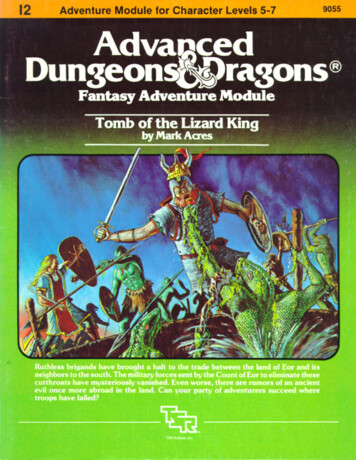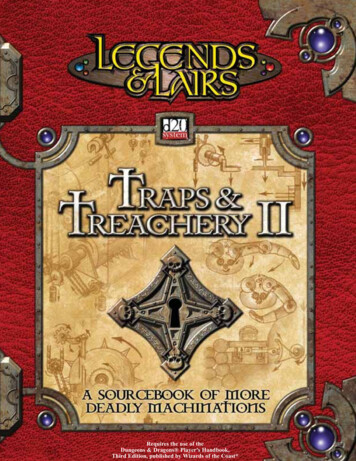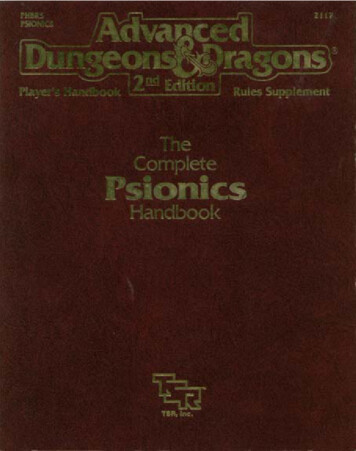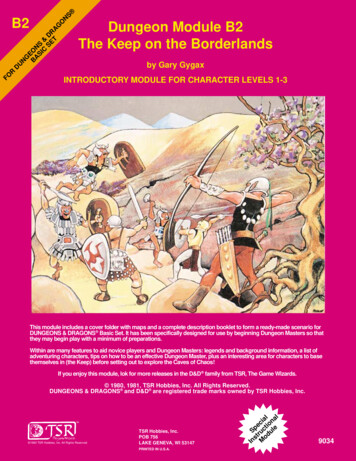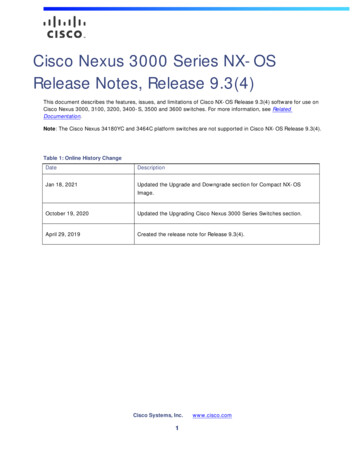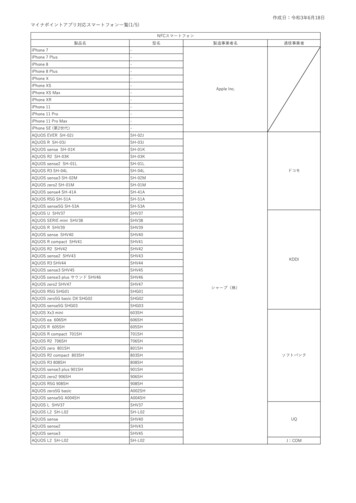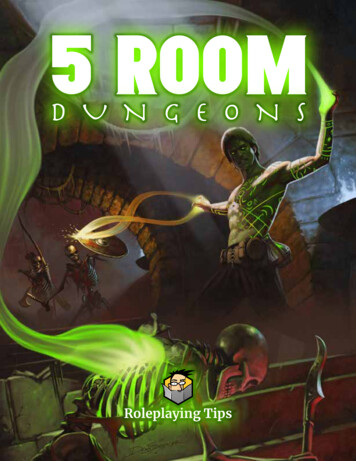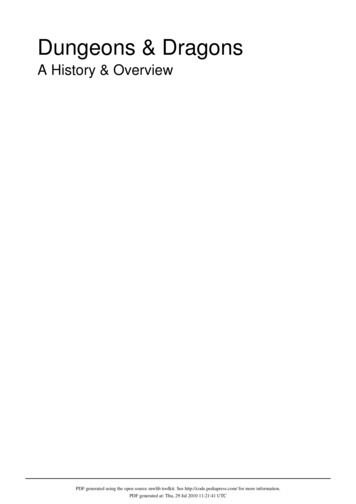
Transcription
Dungeons & DragonsA History & OverviewPDF generated using the open source mwlib toolkit. See http://code.pediapress.com/ for more information.PDF generated at: Thu, 29 Jul 2010 11:21:41 UTC
ContentsArticlesIntroductionDungeons & DragonsThe Early Years1120Sources and influences on the development of Dungeons & Dragons20TSR, Inc.27Dungeons & Dragons (1974)37Dungeons & Dragons Basic Set39Editions of Dungeons & Dragons41Dungeons & Dragons controversies53The WotC Years59d20 System59Wizards of the Coast63Open Game License68About The Game70Dungeons & Dragons game mechanics70Character class (Dungeons & Dragons)77THAC085People86Gary Gygax86Dave Arneson98Ed Greenwood104Monte Cook108Jonathan Tweet110Skip Williams111Books112Dungeon Master's Guide112Player's Handbook115Monster Manual120Monster Manual II124
Fiend Folio128Unearthed Arcana132Oriental Adventures137Settings141Greyhawk141Forgotten Realms171Eberron178ReferencesArticle Sources and Contributors181Image Sources, Licenses and Contributors184Article LicensesLicense186
1IntroductionDungeons & DragonsThe 4th Edition Dungeons & Dragons logoDesignerGary Gygax and Dave ArnesonPublisherTSR, Wizards of the CoastPublicationdate1974 (original); 1977 (D&D Basic Set 1st revision); 1977–1979 (AD&D); 1981 (D&D Basic Set 2nd revision);1983–1986 (D&D Basic Set 3rd revision); 1989 (AD&D 2nd Edition); 1991 (D&D Rules Cyclopedia); 2000 (D&D3rd edition); 2003 (D&D v.3.5); 2008 (D&D 4th edition)Years active1974-presentGenre(s)FantasySystemDungeons & Dragons; d20 SystemPlaying timeVariesRandomchanceDice rollingSkillsrequiredRole-playing, improvisation, tactics, arithmeticWebsitehttp:/ / www. wizards. com/ dndDungeons & Dragons (abbreviated as D&D)[1] is a fantasy role-playing game (RPG) originally designed by GaryGygax and Dave Arneson, and first published in 1974 by Tactical Studies Rules, Inc. (TSR). The game has beenpublished by Wizards of the Coast since 1997. It was derived from miniature wargames with a variation of theChainmail game serving as the initial rule system.[2] D&D's publication is widely regarded as the beginning ofmodern role-playing games and the role-playing game industry.[3]D&D departs from traditional wargaming and assigns each player a specific character to play instead of a militaryformation. These characters embark upon imaginary adventures within a fantasy setting. A Dungeon Master servesas the game's referee and storyteller, while also maintaining the setting in which the adventures occur. The charactersform a party that interacts with the setting's inhabitants (and each other). Together they solve dilemmas, engage inbattles and gather treasure and knowledge.[3] In the process the characters earn experience points to becomeincreasingly powerful over a series of sessions.The early success of Dungeons & Dragons led to a proliferation of similar game systems. Despite this competition,D&D enjoys a dominant market position in the role-playing game industry.[4] In 1977, the game was split into twoversions: the more loose, open framework game system of Dungeons & Dragons and the much tighter and morestructured game system of Advanced Dungeons & Dragons (abbreviated as AD&D or ADnD).[1] [5] AD&D 2ndEdition was published in 1989. In 2000, the original version of the game was discontinued and the AD&D versionwas renamed simply Dungeons & Dragons with the release of its 3rd edition.[6] These rules formed the basis of thed20 System that is available under the Open Game License for use by other publishers. Dungeons & Dragonsversion 3.5 was released in June 2003, with a 4th edition in June 2008.[7]
Dungeons & Dragons2As of 2006, Dungeons & Dragons remains the best-known[8] and best-selling[9] role-playing game, with anestimated 20 million people having played the game and more than US 1 billion in book and equipment sales.[10]The game has been supplemented by many pre-made adventures as well as commercial campaign settings suitablefor use by regular gaming groups. Dungeons & Dragons is known beyond the game for other D&D-brandedproducts, references in popular culture and some of the controversies that have surrounded it, particularly a moralpanic in the 1980s falsely linking it to Satanism and suicide.[11] The game has won multiple awards and has beentranslated into many languages beyond the original English.Play overviewDungeons & Dragons is a structured yet open-ended role-playinggame. It is normally played indoors with the participants seatedaround a table-top. Typically, each player controls only a singlecharacter, which represents an individual in a fictional setting.[12][13]When working together as a group, these player characters(PCs) are often described as a ‘party’ of adventurers, with eachmember often having his or her own areas of specialty thatcontributes to the success of the whole.[14] [15] During the courseof play, each player directs the actions of his or her character andits interactions with the other characters in the game.[16] [17] Agame often continues over a series of meetings to complete asingle adventure, and longer into a series of related gamingadventures, called a ‘campaign’.[18]A D&D game session in progressThe results of the party's choices and the overall storyline for the game are determined by the Dungeon Master (DM)according to the rules of the game and the DM's interpretation of those rules.[19] The DM selects and describes thevarious non-player characters (NPCs) the party encounters, the settings in which these interactions occur, and theoutcomes of those encounters based on the players' choices and actions.[17] [20] Encounters often take the form ofbattles with 'monsters' – a generic term used in D&D to describe potentially hostile beings such as animals ormythical creatures. The game's extensive rules – which cover diverse subjects such as social interactions,[21] magicuse,[22] combat,[23] and the effect of the environment on PCs[24] – help the DM to make these decisions. TheDungeon Master may choose to deviate from the published rules[19] or make up new ones if he or she feels it isnecessary.[25]The most recent versions of the game's rules are detailed in threecore rulebooks: The Player's Handbook, the Dungeon Master'sGuide and the Monster Manual. A Basic Game boxed set containsabbreviated rules to help beginners learn the game.[26]The only items required to play the game are the rulebooks, acharacter sheet for each player and a number of polyhedral dice.The current editions also assume, but do not require, the use ofminiature figures or markers on a gridded surface. Earlier editionsdid not make this assumption.[27] Many optional accessories areavailable to enhance the game, such as expansion rulebooks,pre-designed adventures and various campaign settings.[28]Release 3.5 of the three core rulebooks
Dungeons & DragonsGame mechanicsBefore the game begins, each player creates his or herplayer character and records the details (describedbelow) on a character sheet. First, a player determineshis or her character's ability scores,[29] which consist ofD&D uses polyhedral dice to resolve random events. These breviated as a 'd' followed by the number of sides. From left, d4,d6, d8, d12, d20 and two d10, both of which are used together toWisdom, and Charisma. Each edition of the game hasrepresent a d100, d%, or percentile die.offered differing methods of determining thesestatistics; as of 4th Edition, players generally assigntheir ability scores from a list or use points to "buy" them.[30] The player then chooses a race (species) such asHuman or Elf, a character class (occupation) such as Fighter or Wizard, an alignment (a moral and ethical outlookwhich may have a Good or Evil component, a Lawful or Chaotic component, or something in between), and anumber of powers, skills and feats to enhance the character's basic abilities.[31] Additional background history,usually not covered by specific rules, is often also used to further develop the character.[32]During the game, players describe their PC's intended actions, such as punching an opponent or picking a lock, andconverse with the DM in character – who then describes the result or response.[33] Trivial actions, such as picking upa letter or opening an unlocked door, are usually automatically successful. The outcomes of more complex or riskyactions are determined by rolling dice.[17] Factors contributing to the outcome include the character's ability scores,skills and the difficulty of the task.[34] In circumstances where a character does not have control of an event, such aswhen a trap or magical effect is triggered or a spell is cast, a saving throw can be used to determine whether theresulting damage is reduced or avoided.[35] [36] In this case the odds of success are influenced by the character'sclass, levels and (with the 3rd and later editions) ability scores.[35] [37]As the game is played, each PC changes over time and generally increases in capability. Characters gain (orsometimes lose) experience, skills[38] and wealth, and may even alter their alignment[39] or add additional characterclasses.[40] The key way characters progress is by earning experience points (XP/EXP), which happens when theydefeat an enemy or accomplish a difficult task.[41] Acquiring enough XP allows a PC to advance a level, whichgrants the character improved class features, abilities and skills.[42] Up through the 3rd edition, XP can also be lost insome circumstances, such as encounters with creatures that drain life energy, or by use of certain magical powersthat require payment of an XP cost.[43]Hit points (HP) are a measure of a character's vitality and health and are determined by the class, level andconstitution of each character. They can be temporarily lost when a character sustains wounds in combat orotherwise comes to harm, and loss of HP is the most common way for a character to die in the game.[44] Death canalso result from the loss of key ability scores[45] or character levels.[46] When a PC dies, it is often possible for thedead character to be resurrected through magic, although some penalties may be imposed as a result. If resurrectionis not possible or not desired, the player may instead create a new PC to resume playing the game.[47]In the 4th edition of the game, XP cannot be lost or expended, and ability scores cannot be damaged.Adventures, campaigns, and modulesA typical Dungeons & Dragons game consists of an 'adventure', which is roughly equivalent to a single story.[48]The DM can either design an adventure on his or her own, or follow one of the many additional pre-made adventures(previously known as "modules") that have been published throughout the history of Dungeons & Dragons.Published adventures typically include a background story, illustrations, maps and goals for PCs to achieve. Somealso include location descriptions and handouts. Although a small adventure entitled 'Temple of the Frog' wasincluded in the Blackmoor rules supplement in 1975, the first stand-alone D&D module published by TSR was1978’s Steading of the Hill Giant Chief, written by Gygax.3
Dungeons & Dragons4A linked series of adventures is commonly referred to as a 'campaign'.[49] The locations where these adventuresoccur, such as a city, country, planet or an entire fictional universe, are also sometimes called 'campaigns' but aremore correctly referred to as 'worlds' or 'campaign settings'.[50] D&D settings are based in various fantasy subgenresand feature varying levels of magic and technology.[51] Popular commercially published campaign settings forDungeons & Dragons include Greyhawk, Dragonlance, Forgotten Realms, Mystara, Spelljammer, Ravenloft, DarkSun, Planescape, Birthright and Eberron.[52] Alternatively, DMs may develop their own fictional worlds to use ascampaign settings.Miniature figuresSeveral Dungeons & Dragons miniature figures. The grid mat underneath usesone-inch squares.The wargames from which Dungeons &Dragons evolved used miniature figures torepresent combatants. D&D initiallycontinued the use of miniatures in a fashionsimilar to its direct precursors. The originalD&D set of 1974 required the use of theChainmail miniatures game for combatresolution.[53] By the publication of the1977 game editions, combat was mostlyresolved verbally. Thus miniatures were nolonger required for game play, althoughsome players continued to use them as avisual reference.[54]In the 1970s, numerous companies began to sell miniature figures specifically for Dungeons & Dragons and similargames. Licensed miniature manufacturers who produced official figures include Grenadier Miniatures(1980–1983),[55] Citadel Miniatures (1984–1986),[56] Ral Partha,[57] and TSR itself.[58] Most of these miniaturesused the 25 mm scale, with the exception of Ral Partha’s 15 mm scale miniatures for the 1st edition Battlesystem.[59][60]Periodically, Dungeons & Dragons has returned to its wargaming roots with supplementary rules systems forminiatures-based wargaming. Supplements such as Battlesystem (1985 & 1989) and a new edition of Chainmail(2001)[61] provided rule systems to handle battles between armies by using miniatures.Dungeons & Dragons 3rd Edition (2000) assumes the use of miniatures to represent combat situations in play, anaspect of the game that was further emphasized in the v3.5 revision. The Dungeons & Dragons Miniatures Game(2003) is sold as sets of plastic, randomly assorted, pre-painted miniatures, and can be used as either part of astandard Dungeons & Dragons game or as a stand-alone collectible miniatures game.[62]Game historySources and influencesAn immediate predecessor of Dungeons & Dragons was a set of medieval miniature rules written by Jeff Perren.These were expanded by Gary Gygax, whose additions included a fantasy supplement, before the game waspublished as Chainmail. When Dave Wesely entered the service in 1970, his friend and fellow Napoleonicswargamer Dave Arneson began a medieval variation of Wesely's Braunstein games, where players controlindividuals instead of armies.[63] Arneson used Chainmail to resolve combats.[2] As play progressed, Arneson addedsuch innovations as character classes, experience points, level advancement, armor class, and others.[63] Havingpartnered previously with Gygax on Don't Give Up the Ship!, Arneson introduced Gygax to his Blackmoor game and
Dungeons & Dragonsthe two then collaborated on developing "The Fantasy Game", the role-playing game (RPG) that became Dungeons& Dragons, with the final writing and preparation of the text being done by Gygax.[1] [64] [65]Many Dungeons & Dragons elements also appear in hobbies of the mid- to late twentieth century (though theseelements also existed previously). Character-based role playing, for example, can be seen in improvisationaltheatre.[66] Game-world simulations were well-developed in wargaming. Fantasy milieus specifically designed forgaming could be seen in Glorantha’s board games among others.[67] Ultimately, however, Dungeons & Dragonsrepresents a unique blending of these elements.The theme of D&D was influenced by mythology, pulp fiction, and contemporary fantasy authors of the 1960s and1970s. The presence of halflings, elves, dwarves, half-elves, orcs, dragons, and the like, often draw comparisons tothe work of J.R.R. Tolkien. Gygax maintained that he was influenced very little by The Lord of the Rings (althoughthe owners of that work’s copyright forced the name changes of hobbit to 'halfling', ent to 'treant', and balrog to 'TypeVI demon [balor]'), stating that he included these elements as a marketing move to draw on the popularity of thework.[68] [69]The magic system, in which wizards memorize spells that are used up once cast (and must be re-memorized the nextday), was heavily influenced by the Dying Earth stories and novels of Jack Vance.[70] The original alignment system(which grouped all players and creatures into ‘Law’, ‘Neutrality’ and ‘Chaos’) was derived from the novel ThreeHearts and Three Lions by Poul Anderson.[71] A troll described in this work also influenced the D&D definition ofthat monster.[69]Other influences include the works of Robert E. Howard, Edgar Rice Burroughs, A. Merritt, H. P. Lovecraft, FritzLeiber, L. Sprague de Camp, Fletcher Pratt, Roger Zelazny, and Michael Moorcock.[72] Monsters, spells, and magicitems used in the game have been inspired by hundreds of individual works ranging from A. E. van Vogt’s “BlackDestroyer”, Coeurl (the Displacer Beast), Lewis Carroll’s “Jabberwocky” (vorpal sword) to the Book of Genesis (theclerical spell ‘Blade Barrier’ was inspired by the “flaming sword which turned every way” at the gates of Eden).[71]5
Dungeons & Dragons6Edition historyDungeons & Dragons has gone through several revisions. Parallel versions and inconsistent naming practices canmake it difficult to distinguish between the different editions.The original Dungeons & Dragons, now referred to as OD&D,[73] was asmall box set of three booklets published in 1974. It was amateurish inproduction and written from a perspective that assumed the reader wasfamiliar with wargaming. Nevertheless it grew rapidly in popularity,first among wargamers and then expanding to a more general audienceof college and high school students. Roughly 1,000 copies of the gamewere sold in the first year followed by 4,000 in 1975, with salesincreasing thereafter.[74] This first set went through many printings andwas supplemented with several official additions, such as the originalGreyhawk and Blackmoor supplements (both 1975),[75] as well asmagazine articles in TSR’s official publications and countless fanzines.Two-pronged strategyIn 1977, TSR created the first element of a two-pronged strategy thatwould divide the D&D game for over two decades. A Basic Dungeons& Dragons boxed set was introduced[65] to clean up the presentation ofthe essential rules, make the system understandable to the generalpublic, and placed in a package that could be stocked in toy stores. InThe original Dungeons & Dragons set.1978, Advanced Dungeons & Dragons (AD&D) was published,[65]which brought together the various published rules, options and corrections, then expanded them into a definitive,unified game for hobbyist gamers. The basic set directed players who exhausted the possibilities of that game toswitch to the advanced rules.Unfortunately, almost from its inception, differences of design philosophy caused this dual marketing approach to goawry. Gygax, who wrote the advanced game, wanted an expansive game with rulings on any conceivable situationwhich might come up during play. J. Eric Holmes, the editor of the basic game, preferred a lighter tone with moreroom for personal improvisation. As a result, the basic game included many rules and concepts which contradictedcomparable ones in the advanced game. Confusing matters further, the original D&D boxed set remained inpublication until 1979, since it remained a healthy seller for TSR.[67]Advanced Dungeons & Dragons was designed to create a tighter, more structured game system than the looseframework of the original game.[5] While seen by many as a revision of D&D,[6] AD&D was at the time declared tobe "neither an expansion nor a revision of the old game, it is a new game".[5] The AD&D game was not intended tobe directly compatible with D&D and it required some conversion to play between the rule sets.[76] The termAdvanced described the more complex rules and did not imply "for higher-level gaming abilities". Between 1977 and1979, three hardcover rulebooks, commonly referred to as the "core rulebooks", were released: the Player’sHandbook (PHB), the Dungeon Master’s Guide (DMG), and the Monster Manual (MM). Several supplementarybooks were published throughout the 1980s, notably Unearthed Arcana (1985) that included a large number of newrules.[65]
Dungeons & DragonsRevised editionsIn 1981, Basic Dungeons & Dragons was revised by Tom Moldvay. However, the rules for the Dungeons &Dragons game continued to diverge and it became a separate and distinct product from TSR’s flagship game, AD&D.This game was promoted as a continuation of the original D&D tone, whereas AD&D was an advancement of themechanics.[5] Although simpler overall than the Advanced game, it included rules for some situations not covered inAD&D. There were five sets: Basic (1977, revised in 1981 and again in 1983), Expert (1981, revised in 1983),Companion (1983), Master (1985), and Immortals (1986, revised in 1991). Each set covered game play for morepowerful characters than the previous.[77] The first four sets were later compiled as a single hardcover book, theDungeons & Dragons Rules Cyclopedia (1991).Advanced Dungeons & Dragons 2nd Edition, sometimes referredto as AD&D2 or 2nd Ed, was published in 1989,[65] again as threecore rulebooks; the primary designer was David "Zeb" Cook. TheMonster Manual was replaced by the Monstrous Compendium, aloose-leaf binder that was subsequently replaced by the hardcoverMonstrous Manual in 1993. In 1995, the core rulebooks wereslightly revised, although still referred to by TSR as the 2ndEdition,[78] and a series of Player’s Option manuals were releasedas optional core rulebooks.[65]The release of AD&D2 deliberately excluded some aspects of thegame that had attracted negative publicity. References to demonsand devils, sexually suggestive artwork, and playable, evil-alignedcharacter types – such as assassins and half-orcs – wereremoved.[79] The edition moved away from a theme of 1960s and1970s "sword and sorcery" fantasy fiction to a mixture of medievalhistory and mythology.[80] The rules underwent minor changes,including the addition of non-weapon proficiencies – skill-likeFirst edition Advanced Dungeons & Dragons Dungeonabilities that originally appeared in 1st Edition supplements. TheMasters Guide.game's magic spells were divided into schools and spheres.[1] Amajor difference was the promotion of various game settingsbeyond that of traditional fantasy. This included blending fantasy with other genres, such as horror (Ravenloft),science fiction (Spelljammer), and apocalyptic (Dark Sun), as well as alternative historical and non-Europeanmythological settings.[81]Wizards of the CoastIn 1997, a near-bankrupt TSR was purchased by Wizards of the Coast. Following three years of development,Dungeons & Dragons 3rd Edition was released in 2000.[82] This game is referred to as D&D3 or 3E and is not to beconfused with the 1983 edition of the basic D&D game. The new release folded the Basic and Advanced lines backinto a single unified game. It was the largest revision of the D&D rules to date, and also served as the basis for amulti-genre role-playing system designed around 20-sided dice, called the d20 System.[83] The 3rd Edition ruleswere designed to be internally consistent and less restrictive than previous editions of the game, allowing playersmore flexibility to create the characters they wanted to play.[84] Skills and feats were introduced into the core rules toencourage further customization of characters.[85] The new rules also standardized the mechanics of action resolutionand combat.[86]In 2003, Dungeons & Dragons v.3.5, also known as Revised 3rd Edition or D&D3.5, was released as a revision ofthe 3rd Edition rules. This release incorporated hundreds of rule changes, mostly minor, and expanded the corerulebooks.[86]7
Dungeons & DragonsIn early 2005, Wizards of the Coast's R&D team started to develop Dungeons & Dragons 4th Edition, promptedmainly by the feedback obtained from the D&D playing community and a desire to make the game faster, moreintuitive, and with a better play experience than under the 3rd Edition. The new game was developed through anumber of design phases spanning from May 2005 until its release.[87]Dungeons & Dragons 4th Edition was announced at Gen Con in August 2007, and the initial three core books werereleased June 6, 2008.[7] 4th Edition streamlined the game into a simplified form and introduced numerous ruleschanges. Many character abilities were restructured into "Powers". These altered the spell-using classes by addingabilities that could be used at will, per encounter, or per day. Likewise, non-magic-using classes were provided withparallel sets of options. Wizards of the Coast is releasing other supplementary material virtually through theirwebsite,[88] [89] including player character and monster building programs.[90]Acclaim and influenceBeginning with a French language edition in 1982, Dungeons & Dragons has been translated into many languagesbeyond the original English.[1] [65] By 2004, consumers had spent more than US 1 billion on Dungeons & Dragonsproducts and the game had been played by more than 20 million people.[10] As many as 6 million people played thegame in 2007.[90]The various editions of Dungeons & Dragons have won many Origins Awards, including All Time Best RoleplayingRules of 1977, Best Roleplaying Rules of 1989, and Best Roleplaying Game of 2000 for the three flagship editions ofthe game.[91] Both Dungeons & Dragons and Advanced Dungeons & Dragons are Origins Hall of Fame Gamesinductees as they were deemed sufficiently distinct to merit separate inclusion on different occasions.[92] Theindependent Games magazine placed Dungeons & Dragons on their Games 100 list from 1980 through 1983, thenentered the game into the magazine’s Hall of Fame in 1984.[93] [94]Dungeons & Dragons was the first modern role-playing game and it established many of the conventions that havedominated the genre.[95] Particularly notable are the use of dice as a game mechanic, character record sheets, use ofnumerical attributes and gamemaster-centered group dynamics.[96] Within months of Dungeons & Dragons’s release,new role-playing game writers and publishers began releasing their own role-playing games, with most of thesebeing in the fantasy genre. Some of the earliest other role-playing games inspired by D&D include Tunnels andTrolls (1975),[97] Empire of the Petal Throne (1975), and Chivalry & Sorcery (1976).[98]The role-playing movement initiated by D&D would lead to release of the science fiction game Traveller (1977) andfantasy game RuneQuest (1978), and subsequent game systems such as Chaosium’s Call of Cthulhu (1981),Champions (1982), GURPS (1986),[99] and Vampire: The Masquerade (1992).[67] [100] Dungeons & Dragons and thegames it influenced fed back into the genre’s origin – miniatures wargames – with combat strategy games likeWarhammer Fantasy Battles.[101] D&D also had a large impact on modern video games.[102]Director Jon Favreau credits Dungeons & Dragons with giving him ".a really strong background in imagination,storytelling, understanding how to create tone and a sense of balance."[103]LicensingEarly in the game’s history, TSR took no action against small publishers' production of D&D compatible material.This attitude changed in the mid 1980s when TSR revoked these rights (even from publishers they had earlierofficially licensed, such as Judges Guild),[104] and took legal action to prevent others from publishing compatiblematerial. This angered many fans and led to resentment by the other gaming companies.[67] Although TSR took legalaction against several publishers in an attempt to restrict third-party usage, it never brought any court cases tocompletion, instead settling out of court in every instance.[105] TSR itself also ran afoul of intellectual property lawin several cases.[106] [107]With the launch of Dungeons & Dragons’s 3rd Edition, Wizards of the Coast made the d20 System available underthe Open Game License (OGL) and d20 trademark license. Under these licenses, authors are free to use the d208
Dungeons & DragonsSystem when writing games and game supplements.[108] The OGL and d20 Trademark License also made possiblenew games, some based on licensed products like Star Wars, and also new versions of older games, such as Call ofCthulhu.During the 2000s, there has been a trend towards recreating older editions of D&D. Necromancer Games, with itsslogan "Third Edition Rules, First Edition Feel"[109] and Goodman Games Dungeon Crawl Classics range[110] areboth examples of this in material for d20 System. Other companies have created complete game systems based onearlier editions of D&D. An example is HackMaster (2001) by Kenzer and Company, a licensed, non-OGL,semi-satirical follow-on to 1st and 2nd Edition.[111] Castles & Crusades (2005), by Troll Lord Games, is areimagining of early editions by streamlining rules from OGL[112] that was supported by Gary Gygax prior to hisdeath.[113]With the release of the fourth edition, Wizards of the Coast has introduced its Game System License, whichrepresents a significant restriction compared with the very open policies embodied by the OGL. In part as a responseto this, some publishers (such as Paizo Publishing with its Pathfinder Roleplaying Game) who previously producedmaterials in support of the D&D product line, have made the decision to continue supporting the 3rd Edition rules,thereby competing directly with Wizards of the Coast.[114] [115] Others, such as Kenzer & Company, are returning tothe practice of publishing unlicensed supplements, stressing that copyright law does not allow Wizards of the Coastto restrict third-party usage.[116]Controversy and notorietyAt various times in its history, Dungeons & Dragons has received negative publicity, in particular from someChristian groups, for alleged promotion of such practices as devil worship, witchcraft, suicide, and murder, and fornaked breasts in drawings of female humanoids in the original AD&D manuals (mainly monsters such as Harpies,Succubi, etc.).[11] [117] These controversies led TSR to remove many potentially controversial references and artworkwhen releasing the 2nd Edition of AD&D.[79] Many of these references, including the use of the names "devils" and"demons", were reintroduced in
PDF generated at: Thu, 29 Jul 2010 11:21:41 UTC Dungeons & Dragons A History & Overview. Contents Articles Introduction 1 Dungeons & Dragons 1 The Early Years 20 Sources and influences on the development of Dungeons & Dragons 20 TSR, Inc. 27 Dungeons & Dragons (1974) 37 Dungeons & Dragons Basic Set 39


